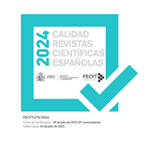Organización retórica del género Informe de Estabilidad Financiera: un contraste entre el informe del Banco Central de Chile y del Banco Federal Alemán
Resumen
Estudiar la organización retórica de los géneros discursivos ha permitido conocer los patrones de regularidad que subyacen al modo en que se organiza el conocimiento de un género y cómo va configurándose para la consecución de sus propósitos comunicativos. El objetivo del presente estudio es describir la organización retórica del género Informe de Estabilidad Financiera (IEF) en español y en alemán, a partir de un corpus proveniente del Banco Central de Chile y del Banco Federal Alemán. Para llevar a cabo la identificación de la estructura retórico-funcional, se adoptó la propuesta de identificación de movidas de Swales (1990, 2004). Los resultados indican que la organización retórica del género IEF está compuesta por tres macromovidas: Presentación, Revisión de la estabilidad financiera y Respaldo bibliográfico. Asimismo, se observó que en ambas lenguas esta organización difiere, puesto que en español existe una cuarta macromovida, Orientaciones para la lectura. Por otro lado, en alemán, la macromovida tres, Respaldo bibliográfico, se encuentra inserta en la macromovida dos, Revisión de la estabilidad financiera. En ambas lenguas, la macromovida Revisión de la estabilidad financiera es la más relevante para la consecución del propósito comunicativo del género que es guiar la estabilidad financiera de un país.Descargas
Descarga artículo
Licencia
La revista Círculo de Lingüística Aplicada a la Comunicación, para fomentar el intercambio global del conocimiento, facilita el acceso sin restricciones a sus contenidos desde el momento de su publicación en la presente edición electrónica, y por eso es una revista de acceso abierto. Los originales publicados en esta revista son propiedad de la Universidad Complutense de Madrid y es obligatorio citar su procedencia en cualquier reproducción total o parcial. Todos los contenidos se distribuyen bajo una licencia de uso y distribución Creative Commons Reconocimiento 4.0 (CC BY 4.0). Esta circunstancia ha de hacerse constar expresamente de esta forma cuando sea necesario. Puede consultar la versión informativa y el texto legal de la licencia.











